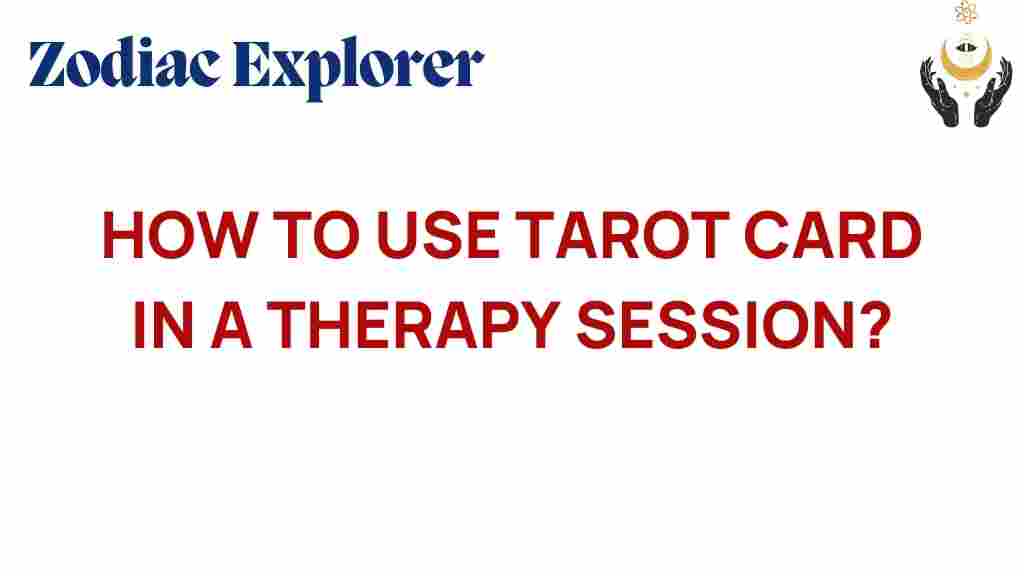Unlocking the Mysteries: How to Use Tarot Cards in Therapy for Tarot Therapy
In recent years, the integration of Tarot therapy into mental health practices has gained popularity as people seek innovative ways to foster healing and self-discovery. Tarot cards, traditionally viewed as tools for divination, are now being embraced in therapeutic settings for their potential to provide intuitive guidance, promote mindfulness, and facilitate spiritual growth. In this article, we will explore how Tarot therapy can be used effectively in counseling and psychology to enhance mental health.
Understanding Tarot Therapy
Tarot therapy blends the symbolic meanings of tarot cards with psychological principles to support individuals on their journey toward healing and self-discovery. Unlike traditional therapy, which often focuses on verbal communication and cognitive restructuring, Tarot therapy incorporates visual and intuitive elements that can unlock deeper insights.
Here are the core components of Tarot therapy:
- Intuitive Guidance: Tarot cards act as prompts that encourage individuals to tap into their intuition and explore their thoughts and feelings.
- Symbolism: Each card contains rich symbolic imagery that can reflect the client’s current state of mind and emotions.
- Mindfulness: The practice encourages individuals to be present in the moment, enhancing awareness of their psychological state.
- Spirituality: Tarot can facilitate a connection to one’s spiritual beliefs, fostering a sense of purpose and meaning.
The Benefits of Tarot Therapy
Integrating Tarot therapy into mental health practices can offer numerous benefits, including:
- Enhanced Self-Discovery: Tarot prompts clients to explore their inner thoughts and feelings, leading to greater self-awareness.
- Improved Emotional Processing: The visual nature of tarot cards can help clients articulate emotions that may be difficult to express verbally.
- Empowerment: Clients often feel empowered when they gain insights from the cards, fostering a sense of agency in their healing process.
- Creative Expression: Tarot encourages creative thinking, allowing clients to approach problems from different angles.
How to Use Tarot Cards in Therapy
Now that we understand the essence of Tarot therapy, let’s delve into a step-by-step process on how to effectively incorporate tarot cards into therapeutic practices.
Step 1: Choose the Right Tarot Deck
Selecting a tarot deck that resonates with you is essential. There are many types of decks available, each with its unique artwork and symbolism. Some popular choices include:
- Rider-Waite Tarot: A classic deck known for its straightforward imagery.
- Thoth Tarot: A deck rich in esoteric symbolism, popular among those interested in spirituality.
- Wild Unknown Tarot: A modern deck that emphasizes a more intuitive approach.
Choose a deck that speaks to your intuition and aligns with your therapeutic goals.
Step 2: Set the Intention
Before a session, it’s important to set a clear intention for the use of tarot cards. This can include:
- Focusing on a specific issue or question.
- Creating a safe space for exploration.
- Encouraging openness to insights and revelations.
Having a clear intention helps guide the session and provides direction for the cards drawn.
Step 3: Conducting the Reading
During the session, follow these steps to conduct a Tarot reading:
- Shuffle the Deck: Allow the client to shuffle the cards while focusing on their question or intention.
- Draw Cards: Depending on the spread being used, draw a set number of cards (e.g., three for past, present, future).
- Interpret the Cards: Discuss the meanings of the drawn cards and how they relate to the client’s situation.
- Encourage Reflection: Ask open-ended questions to guide the client’s reflection on the cards’ messages.
Step 4: Integration and Action Plan
After interpreting the cards, work with the client to develop an action plan based on insights gained. This can include:
- Setting goals for personal growth.
- Identifying coping strategies for challenges.
- Encouraging mindfulness practices to reinforce insights.
Integrating the insights from the tarot reading into actionable steps can enhance the therapeutic process.
Step 5: Follow-Up
After the session, it is vital to allow for follow-up discussions. This can help assess the impact of the tarot reading and any changes in the client’s mindset or behavior. Check in on:
- Progress towards goals set during the session.
- Any lingering questions or feelings about the reading.
- New insights or challenges that may have emerged.
Troubleshooting Tips for Tarot Therapy
While Tarot therapy can be a powerful tool for self-discovery and healing, practitioners might encounter challenges. Here are some troubleshooting tips:
Challenge 1: Resistance to Tarot
Some clients may feel skeptical or resistant to using tarot cards. To address this:
- Educate: Explain the therapeutic benefits of tarot therapy and how it differs from traditional fortune-telling.
- Start Small: Introduce a single card reading to ease them into the experience.
Challenge 2: Misinterpretation of Cards
Clients may struggle with understanding the cards’ meanings. To mitigate this:
- Guide the Interpretation: Encourage clients to express their feelings about the cards rather than relying solely on textbook meanings.
- Use Visual Aids: Provide imagery or references to help them connect with the symbolism.
Challenge 3: Emotional Overwhelm
Some tarot readings may trigger strong emotions. If this occurs:
- Practice Mindfulness: Encourage deep breathing or grounding techniques to help clients manage overwhelming feelings.
- Follow-Up Support: Offer additional sessions to explore any emotional responses that arise.
Conclusion
Tarot therapy offers a unique and enriching approach to mental health, self-discovery, and healing. By integrating tarot cards into therapeutic practices, counselors can provide clients with intuitive guidance that fosters mindfulness and spiritual growth. As with any therapeutic tool, it’s essential to approach Tarot therapy with an open mind and a clear intention. Whether you’re a mental health professional or someone interested in personal growth, understand that Tarot therapy can be a powerful ally in the journey toward emotional well-being.
For further reading on integrating spirituality into counseling, you can check out this resource. If you’re looking for more insights on mental health strategies, visit this page for additional information.
This article is in the category Myths and created by ZodiacExplorer Team
